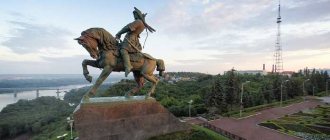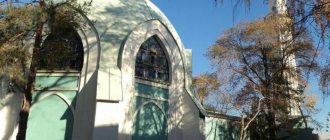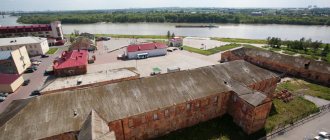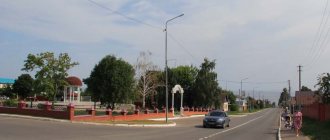The sights of Omsk reveal the rich history of a relatively young and dynamically developing city.
A border fortress, the capital of the Cossack army and even a place of exile - in such guises he appeared at different times, leaving buildings, sculptures and other memorials as souvenirs, a list of which is posted on https://www.syl.ru/article/158814/new_dostoprimechatelnosti -omska-foto-i-otzyivyi-turistov-reyting-dostoprimechatelnostey-omska. The main attractions can be divided into several groups.
Photo: syl.ru
Brief description of the city
Located in the south of the West Siberian Plain, Omsk is the second most populous Siberian city with an area of 566.9 km² and one of the largest cities in Russia, which gives it the right to claim the role of the third capital of the Russian Federation. The Trans-Siberian Railway runs from east to west through Omsk. From south to north the city is crossed by the Irtysh River, which is navigable. Omsk is located on a flat area at the place where the Irtysh River, which has a length of more than 25 kilometers within the city, flows into the Om River. There are many small rivers and lakes in the city and suburbs.
The Irtysh divides the city into two parts - the right bank and the Left Bank, and the left bank began to be built up only in 1973
Omsk is a million-plus city with a population of 1,172,070 people, more than 80% of whom are Russian.
The time zone of Omsk is three hours ahead of Moscow. These two cities are separated by 2242 kilometers.
Historical reference
The development of Omsk is directly related to the development of Siberian lands. The first settlements in the city date back to the 6th century BC. e. At the beginning of our era, there were camps of Andronovo, Irmen, Kulai, and Xiongnu people here. In the 16th century, the local population, being in diplomatic relations with Russia, asked Tsar Peter I to help build a fortress to counter attacks from neighboring khanates. The first fortification, built under the leadership of Colonel Ivan Buchholz, was destroyed, but the second attempt to build an outpost was successful.
The date of construction of the Omsk fortress is considered to be May 4–5, 1716 according to the old style, that is, in fact, the beginning of the city should be celebrated on May 16, but City Day in Omsk is usually celebrated on the first Sunday in August.
In the middle of the 18th century, the outpost was fortified to protect the eastern borders of the Russian Empire. At the same time, the city was built up haphazardly, since the defensive structure often burned.
The 19th century in the history of Omsk is associated with famous convicts who served sentences in Siberia: Decembrists, writers (in particular F.M. Dostoevsky, who captured his impressions of the city in “Notes from the House of the Dead”). At the end of the last century, the Trans-Siberian Railway passed through Omsk, giving impetus to the development of trade and industry. Despite the protests of the workers, A. Kolchak came to the city in 1918, and Omsk became the White capital. However, two years later, Soviet power was established in Siberia.
During the Great Patriotic War, many industrial enterprises were moved to Omsk, which contributed to the formation of a large industrial metropolis in the city, as well as the development of synthetic rubber production and the operation of an oil refinery. All this led to the expansion of the city’s borders to modern ones. However, the prosperity of Omsk during the Soviet period was leveled out during the perestroika years: the once flourishing city fell into decay. But now the city is slowly coming to its senses: buildings are being restored (many of them have become cultural heritage sites under the protection of UNESCO), architecture is being updated.
Video: history of the third capital
Table: how to get to Omsk
| Kind of transport | Route | Approximate travel time |
| Airplane (Omsk International Airport operates in the city) | from Moscow | 3 hours 15 minutes |
| from Saint-Petersburg | 3 hours 45 minutes | |
| Train | from Moscow | 39 hours |
| from Saint-Petersburg | 48 hours 15 minutes | |
| Bus | There is no bus service with Moscow and St. Petersburg | |
| from Tyumen | 9 hours 45 minutes | |
| from Khanty-Mansiysk | 18 hours | |
| from Surgut | 21 o'clock | |
| Automobile | from Moscow | 35 hours |
| from Saint-Petersburg | 43 hours | |
| from Rostov | 39 hours | |
Plumber Stepanych and his firefighter friend
There are a great many street sculptures in Omsk. Some of them were installed relatively recently, but new monuments continue to appear on the streets of the city today. One of the most famous among them is the monument to the plumber. Omsk became famous throughout Russia thanks to such an unusual attraction. The monument represents a plumber in work clothes and a helmet leaning out of a sewer manhole up to the middle of his chest, looking good-naturedly at passers-by. Immediately after installation, people nicknamed him Stepanych, or Stepan. It is believed that if you treat this character with vodka and cigarettes from time to time, you won’t have any problems with the plumbing in your own home. It is also considered a good omen to simply make a wish and stroke the monument to the plumber.
Omsk is a city where other representatives of working professions are revered. On the fire tower in this city you can see the figure of a fire fighter, and in the very center of the city on the pedestrian part of the street there is a monument to a policeman who controls order.
What to see in Omsk
Omsk has attractions, as they say, for every taste.
Omsk fortress
The construction of a citadel to protect the southern borders from nomads made Omsk the main settlement of Western Siberia. After the outpost lost its defensive significance, the structure was torn down, and the territory began to be actively developed. As a result, only a fragment has reached us, located within the boundaries of the military unit. And on the site of the fortress, city museums were built and public gardens were laid out.
Reconstruction of the fortress was completed in 2009
The Omsk Fortress Museum offers 17 excursions on the history of the region, designed for visitors of different ages. In addition, the historical and cultural center hosts various entertaining public events: festivals, competitions, forums, exhibitions, craft fairs and master classes on wielding a pike, saber, making folk toys from clay, and souvenir coins.
Tara Gate
The reconstruction of the gates of the Omsk fortress on Spartakovskaya Street is recognized as one of the architectural symbols of the city. The gate was built in 1792, and in 1959 it was completely dismantled in just one night. The building was restored in 1991, dedicating it to the 275th anniversary of Omsk.
The reconstructed gate is not a copy of the lost one. So, in order to house a museum in them, not two niches were made, but four. And you can get to the museum via an internal staircase in one of the niches.
The most romantic sculptures of Omsk
One of the most sentimental monuments of the city is “Lyuba”. On Lyubinsky Prospekt you can see the majestically sad figure of a girl sitting on a bench with a straight back. This is Lyubov Feodorovna, the wife of the local governor Gustav von Gasford. This young woman's story is tragic. Lyubov was 30 years younger than her husband. She arrived in Omsk and almost immediately fell ill with consumption, and died some time later. Contemporaries remembered her as a girl of incredible beauty.
The monument to Lyubochka depicts an unhappy woman on a bench for a reason. The illness took all her strength, and Lyubov Fedorovna just walked - going out into the street and sitting on a bench, since it was difficult for her to walk for a long time. An unusual and interesting monument is a sculpture of a pair of storks in a nest with a clutch of eggs. This sculpture is “The Birth of Happiness,” especially loved by newlyweds. As you might guess, the monument is dedicated to the family; people often make wishes related to the birth of children near it.
Trip to Omsk with children
The city has entertainment for children of all ages. Very young children can go on fun rides in the parks and go to the children's zoo. In addition, kids may be interested in going to a puppet theater. And not only to watch the performance, but also to see the exhibition fund of dolls.
For children of any age, a trip to the water park will be an exciting adventure. Schoolchildren (and their parents) will certainly love the Joule Park wonderland.
In Joule Park you can take part in a master class by a funny chemist
The strangest sculptures
One of the most incomprehensible monuments in the city is “Children Feeding Penguins.” It is worth noting that the sculpture appeared in Omsk back in the 50s of the last century. However, there is no exact information about what it is dedicated to. Original and unusual monuments of Omsk - a monument dedicated to a clothespin and a miniature Eiffel Tower installed on the banks of the Irtysh. Near the replica of the main attraction of Paris you can also see a bronze train, which is especially popular with children.
Routes around Omsk for short and long holidays
There are plenty of places worth visiting in the million-plus city. But if the trip is designed for three days, then it is worth dividing the time between a visit to the Omsk fortress, walks along the Irtysh embankment, a photo shoot against the backdrop of original Omsk sculptures, a trip to museums (for example, the Vrubel Museum and Joule Park), as well as a beach holiday or, if weather permits, excursions to the arboretum and Bird Harbor.
Those who have one more day left can be advised to go to the puppet theater or see the cathedrals.
If you have a week allotted to get to know Omsk, then your tourist route should include a promenade to the Tara and Tobolsk Gates, excursions to the Kolchak Museum and the Literary Museum, as well as a visit to the water park.
You should definitely include walks around the city in your tourist route.
Original creations by A. Kapralov
Sculptor A. Kapralov decorated the city of Omsk with several very unusual monuments. The style of this master is difficult to confuse with anything else. His works surprise and amaze the imagination. If you start to look at these monuments up close, you will notice that they look as if they were welded by a group of enthusiasts in a nearby garage from scrap metal. However, having assessed all the small details and the overall appearance of the composition, it is impossible not to recognize the genius of the sculptor. “Scales of Being” is one of the master’s largest works in Omsk.
The complex and large composition symbolizes the internal struggle of every person between the material and the spiritual. “Communal Crucian Carp” continues this theme – an image of the fabulous “Miracle Juda” in a modern interpretation. On the back of a large fish there are multi-story buildings, stairs, and antennas. Don Quixote is another work by A. Kapralov. The sculpture amazes with the combination of the forward figure of a horse and a majestically calm rider. All these monuments of Omsk, due to their original style of execution, are considered the most unusual in the city.
What's nearby
The Tara Gate is located in the historical center of Omsk, so you can continue your tourist walk by exploring neighboring attractions. This list can include Victory Square and Dzerzhinsky Square, located in the park blocks from the Tara Gate. This is a large-scale memorial complex with green areas, which are especially beautiful in the summer.
Also a few hundred meters from the Tara Gate there is the Assumption Cathedral and several monuments. These include the sculpture Lyubochka, the Plumber Stepanych, the monument to Lenin, the Tobolsk and Omsk Gates. In addition, there are several museums within walking distance from the Tara Gate. In other words, this area is very rich in attractions, so you shouldn’t limit yourself to visiting the Tara Gate.
© Inna Baidakova
How to get there
The Tara Gate of the Omsk Fortress is located on Spartakovskaya Street. To get to this point, you can use public transport. Within walking distance is the “Dramater” stop, which is served by buses No. 73, 336, 355. A little further is the “Hospital” stop, which is served by buses No. 20, 23, 24, 25, 31n, 32, 33, 49, 199 , as well as trolleybuses No. 2, 4 and minibuses No. 64, 201, 212, 222, 323, 307 and many others. For the most comfortable trip, you can use taxi services, for example, Yandex.Taxi or Uber. When driving a personal car, enter coordinates 54.987807, 73.368017 to build the most accurate route.
Tara Gate in Omsk on video:
Gate on Google Maps panoramas, view from Tara Street:
Symbols of Omsk
The “Power” monument is one of the symbols of the city. This is a large ball, decorated with relief inserts, which depict the entire history of the development of Siberia. The sculpture is dedicated primarily to the founder of the city - the legendary I. D. Buchholz.
Many monuments of Omsk tell about the history of this settlement and its region. A striking example of this is the sculpture of a railway worker with a map of railway tracks. Another landmark monument for the city is the monument dedicated to the annual Siberian International Marathon. The composition depicts the winning athlete who came first to the finish line. Interestingly, a new surname appears on the pedestal every year - the one who wins the traditional competition.











